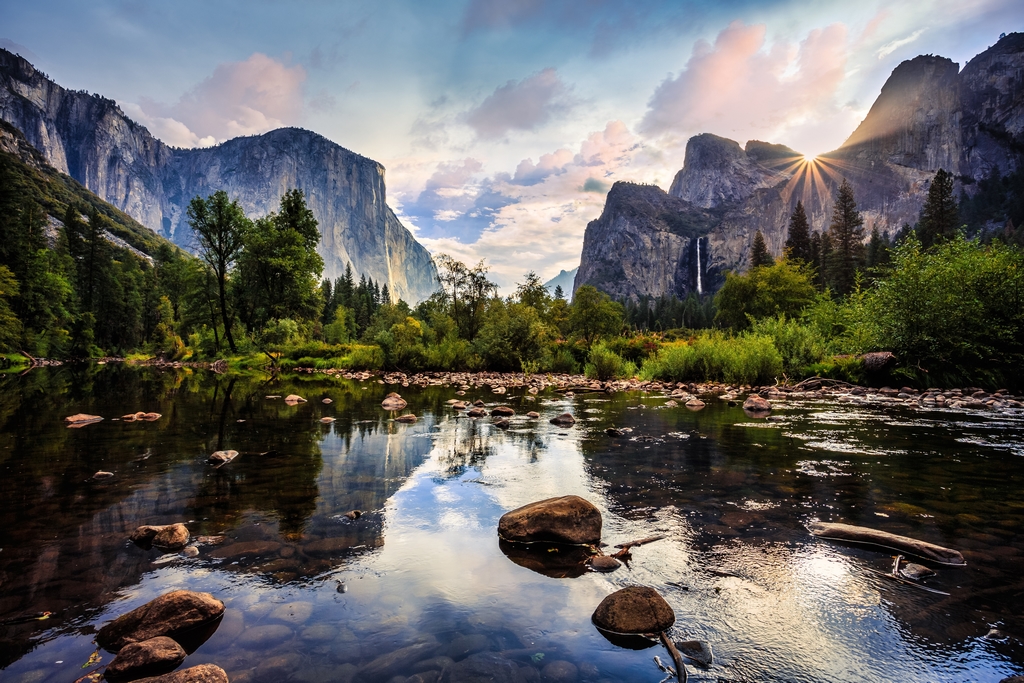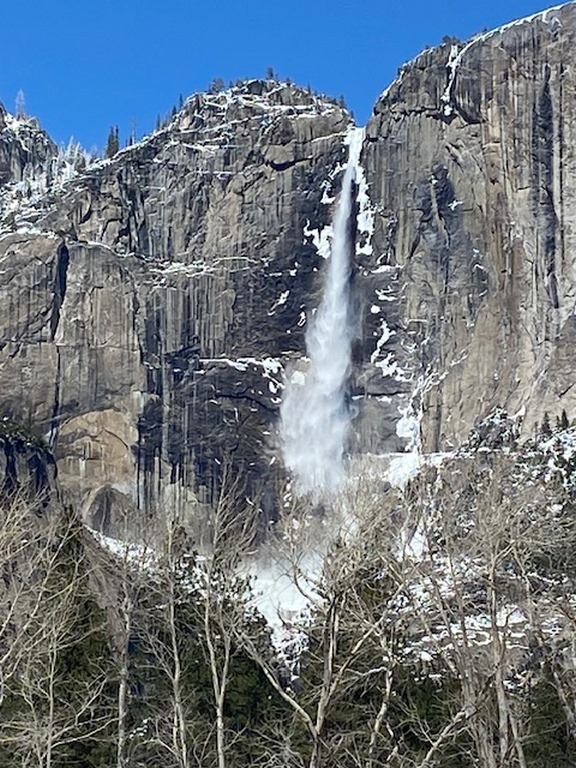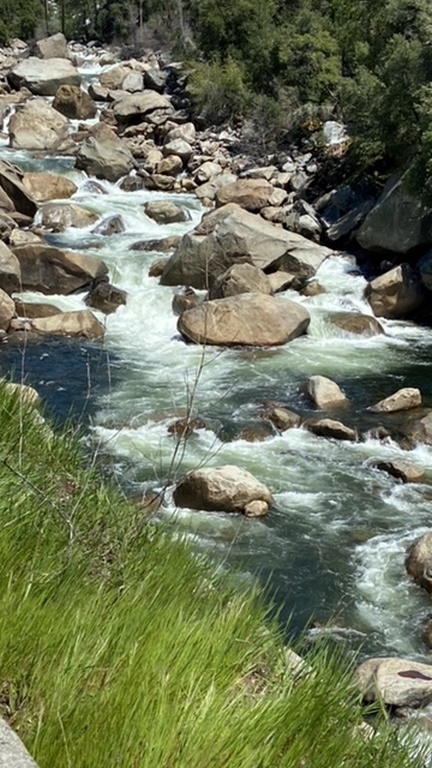The Waters of Yosemite: A Tale of Nature’s Majesty


Nestled within the heart of the Sierra Nevada mountains in California lies Yosemite National Park, a land of breathtaking natural beauty and awe-inspiring landscapes. The waters that have shaped its iconic landscape stand among the park’s many natural wonders.
By Eric Herman
Author’s note: This essay was inspired by a visit to Yosemite National Park in April of this year. My wife, Diane, and I were invited to join Dave Peterson and his staff from Watershape Consulting for an off-site staff development trip. Despite a massive spring storm that literally dumped eight feet of snow in the area, visiting Yosemite was nonetheless a truly inspiring experience.
The word “awesome” is badly overused these days. When it’s used to describe the wonder of Yosemite National Park, however, the term is perfectly suited. The place does, indeed, inspire awe.
Yosemite Valley, carved by the erosive power of glaciers millions of years ago, is a testament to the geological forces that have shaped the landscape over eons. The towering granite cliffs, including the world-famous Half Dome and El Capitan, are enduring symbols of the park’s dynamic geological history as they stand like majestic silent sentinels over the valley below.
From the cascading waterfalls to the meandering rivers and tranquil lakes, Yosemite’s waters have captivated visitors for centuries, offering a glimpse into the park’s rich history, geology, and ecological significance.
The history of Yosemite Valley is also intertwined with the indigenous peoples who have called this land home for thousands of years. The Ahwahneechee people, part of the larger Miwok tribe, were the original inhabitants of the valley, living in harmony with the natural world around them. For generations, they revered the land and its waters, seeing them as sacred gifts from the gods.
European-American exploration of Yosemite began in the mid-19th century, with the Mariposa Battalion’s discovery of the valley in 1851. The subsequent influx of settlers and tourists sparked interest in preserving the area’s natural beauty, leading to the establishment of Yosemite National Park in 1890 after a tireless campaign led by the legendary naturalist John Muir.
Since then, millions of visitors from around the world have flocked to Yosemite to marvel at its wonders and experience the tranquility of its waters. Since its discovery, Yosemite is a place that very much lives in the imagination of the world.
ICONIC FEATURES
At the heart of Yosemite Valley flows the Merced River, a vital lifeline that sustains the park’s rich ecosystem. Originating high in the Sierra Nevada mountains, the Merced winds its way through the valley, feeding the iconic waterfalls and meandering past lush meadows and dense forests. Its crystal-clear waters and unspoiled banks are a haven for wildlife, supporting a diverse array of plant and animal species.
The Merced River’s significance extends beyond its role in the park’s ecology; it also holds cultural and recreational importance for visitors and locals alike. From whitewater rafting and fishing to leisurely strolls along its banks, the river offers endless opportunities for exploration and enjoyment. However, its powerful currents and unpredictable nature demand respect and caution, reminding us of the raw power of nature.
Rising majestically from the valley floor, Half Dome and El Capitan are two of Yosemite’s most iconic landmarks, each with its own unique geology and allure. Half Dome, with its sheer granite face and distinctive shape, has long been a symbol of adventure and exploration. Climbers from around the world flock to its towering cliff face, seeking the ultimate challenge and the chance to stand atop its lofty peak.
El Capitan, the largest granite monolith in the world, is equally impressive in its scale and grandeur. Rising over 3,000 feet from the valley floor, its sheer cliffs attract some of the most skilled rock climbers on the planet, drawn by the challenge of scaling its vertical faces. For many, witnessing the daring feats of climbers on El Capitan is a highlight of their visit to Yosemite, a testament to the indomitable spirit of human endeavor.
It is not a place for those with a fear of heights.
LEGENDARY FALLS
As famous as its stone monoliths, Yosemite’s pair of historic waterfalls have inspired awe, legend and poetry for generations.
Graceful and ethereal, Bridalveil Falls is the epitome of elegance in Yosemite Valley. As visitors approach the valley, this iconic waterfall greets them with its delicate veil of mist, shimmering in the sunlight like a bridal veil floating on the breeze.
Tumbling from a height of 620 feet, Bridalveil Falls is a captivating sight to behold, its waters cascading over granite cliffs with effortless grace. Legend has it that inhaling the mist of Bridalveil Fall guarantees a lifetime of happiness, a testament to its mystical allure.
Standing as the tallest waterfall in North America, Yosemite Falls is a towering titan of water and stone, commanding attention with its sheer magnitude and thunderous roar. Plummeting a staggering 2,425 feet in three distinct tiers, Yosemite Falls is a sight to behold from every vantage point in the valley. From the base of the falls, visitors are dwarfed by the towering cliffs as torrents of water crash down, creating a mesmerizing spectacle of spray and sound.
During the spring thaw, Yosemite Falls roars to life, its waters thundering down the granite cliffs with tremendous force. As the mist rises from the base of the falls, rainbows dance in the sunlight, painting the valley with vibrant hues of color and ever-shifting light. From the iconic Tunnel View vista point, Yosemite Falls stands as a majestic sentinel, presiding over the valley with timeless grandeur.
These majestic waterfalls serve as a reminder of nature’s raw power and resilience, shaping the landscape with every drop of water that cascades down the granite cliffs. As visitors stand in awe of these natural wonders, many say they are humbled by the magnitude of the forces that have sculpted Yosemite Valley over millennia.
It is a place that connects all who venture there with the distant past.
PRETTY AS A PICTURE
One of Yosemite’s most famous visitors and advocates, Ansel Adams was renowned for his pioneering work in landscape photography. He dedicated a significant portion of his career to capturing the ever-changing beauty of Yosemite Valley; efforts that were not just about creating visually stunning images but also advocating for conservation and environmental awareness.
His legendary black-and-white photographs of Yosemite Valley were taken over several decades and are widely celebrated for their remarkable clarity, tonal range, and composition. Through his lens, Adams sought to convey the grandeur and majesty of the natural world, particularly in Yosemite, which he considered a spiritual sanctuary.
Adams’ commitment to Yosemite went beyond mere photography. He was a staunch conservationist and played a pivotal role in raising awareness about the need to preserve natural landscapes. His images served as powerful tools in advocating for the protection of national parks, including Yosemite.
Adams’ work in Yosemite also inspired the establishment of the Ansel Adams Gallery, located in Yosemite Village, which continues to showcase his photographs and promote environmental stewardship.
SEASONAL SENSATIONS
Yosemite National Park welcomes millions of visitors each year, drawn by its natural beauty, outdoor recreation opportunities, and cultural heritage. The park experiences peak visitation during the summer months when the weather is mild, and the waterfalls are at their fullest.
However, Yosemite’s popularity also brings challenges, including overcrowding, traffic congestion, and strain on resources.
Park safety is a top priority for Yosemite’s rangers and staff, who work tirelessly to ensure the well-being of visitors and protect the park’s natural and cultural resources. From providing wilderness education and emergency services to enforcing park regulations and maintaining infrastructure, their efforts are essential to preserving Yosemite for future generations.
Indeed, the waters of Yosemite are a testament to the enduring power and beauty of nature, shaping the landscape and captivating the imagination of all who visit.
It is this author’s opinion that as stewards of this precious wilderness, it is our responsibility to cherish and protect these waters for generations to come, ensuring that Yosemite remains a sanctuary of natural wonder for all to enjoy.
Opening image by Stephen Moehle | Shutterstock. Lower images by Eric Herman.












